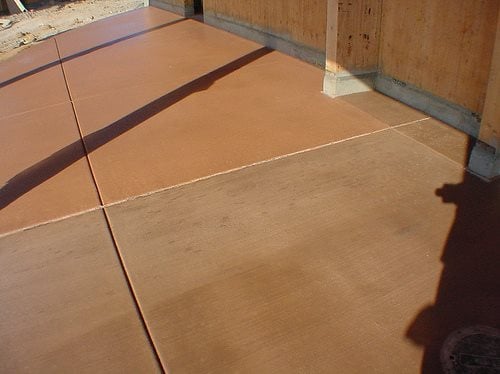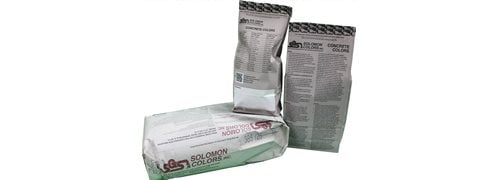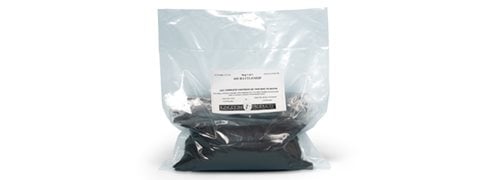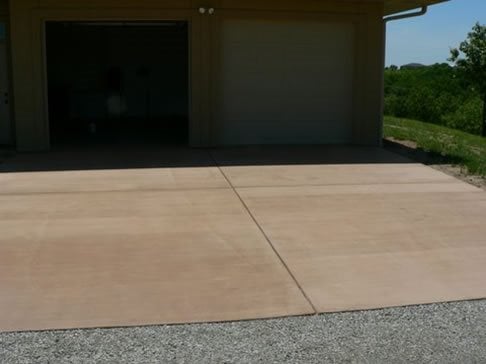- Integral Color Home
- Integral Color vs. Color Hardener for Stamped Concrete
- Tips for Getting the Best Results
- Common Integral Color Issues: Troubleshooting Tips from Expert Chris Sullivan
- Tips for Achieving Consistent Color
- Changing the Color of Integral Concrete
- Related Information:
- Comparison Chart of Concrete Coloring Products
- Product Newsletter Sign Up Today to Receive Monthly Updates
Changing the Color of Integral Colored Concrete

Not all efflorescence is undesirable. Here it's being created intentionally to lighten integrally colored concrete that's too dark.
Question:
I have an integrally colored driveway that was supposed to be light gray, but the ready mix supplier used the wrong color and now I have a black charcoal driveway. Is there anything I can do to change the color from black to light gray? Part of the driveway is broom finished, while some of it is exposed aggregate.
Answer:
This is one of the hardest issues to deal with. Because integral color is such a durable and "integral" part of the concrete, it's very difficult to change the color. Going from a light to a dark color can be achieved with tinted sealers and colored coatings. But to go from dark to light, without making the surface look like it has been painted, often requires application of a micro-thin colored overlay. However, this is a costly fix and will not work over exposed aggregate.
Need color correction help? Find concrete contractors near me.
One off-the-wall method I have recommended that has proven successful in certain cases is to purposely try to generate the formation of efflorescence. Yes, that naturally-occurring white salt residue that most people want to eliminate from their colored concrete because it has a natural lightening effect (often mistaken for color fading). In this case, though, you want to reduce the color intensity and tone down the darkness from black to gray, and efflorescence can help you do that. For this to work, the concrete must be free of all sealers and curing compounds. Use a garden hose or pressure washer, and saturate the concrete surface with lots of water. Then let Mother Nature take effect. Multiple water-soaking cycles may be needed, and there is no guarantee that the color will lighten to the desired shade, if at all.
Another strategy that can help in this situation is not to use a topical membrane-forming sealer. These products will enhance the color and darken the substrate. Consider using an internal impregnating sealer that will penetrate and seal the concrete, but not darken the color.
 Solomon Integral Color
Dry and liquid pigments for coloring concrete
Solomon Integral Color
Dry and liquid pigments for coloring concrete
 Butterfield Integral Color
In Repulpable Bags - Toss the Bag Into the Mixer
Butterfield Integral Color
In Repulpable Bags - Toss the Bag Into the Mixer
 Integral Colors - Dry
By Kingdom Products: Suitable for all types of colored concrete
Integral Colors - Dry
By Kingdom Products: Suitable for all types of colored concrete
Question:
I have a two-toned integrally colored concrete driveway that was poured three years ago. The brown color was significantly lighter than it appeared on the swatch. The installer tried to tint it with a tinted sealer, but it didn't help much and I have hated it ever since. It’s time to pressure wash and reseal the driveway and I am thinking about acid washing for a darker finish. I know this is not ideal, but are there better options than just living with it?

This integrally colored concrete driveway is too light and has faded. But there are remedies for revivng the color.
Answer:
Sorry to hear you didn’t get the color you were looking for, but you do have some options for changing it, depending on the degree of color change you want. The tinted sealer your contractor already tried is a low-cost solution, but it’s a short-term fix and the color change is very subtle. Instead, try some of these remedies:
- Solid-color stainThis is a good option if you want to dramatically change the color of the concrete. These are water-based stains and require the concrete to be free of all other sealers and coatings, since they penetrate into the concrete rather than forming a surface film. They will provide a natural colored concrete look once cured, and no additional sealer is required, but can be used if desired.
- Translucent acrylic stainThis type of stain provides semi-translucent color and is a good option if you want to add some subtle color or highlights. As when applying solid-color stains, the concrete must be free of all sealers and coatings to allow it to penetrate. Usually a sealer is required to lock in color.
- Reactive stainReactive, or acid-based chemical stains, provide semi-translucent color with natural variation and marbling. They also penetrate the concrete, so existing coats of sealer must be removed.
- Cement-based toppingThis is the most expensive option in terms of both material and labor costs. However, a cement-based topping, or overlay, will completely cover and recolor the concrete surface. In order for the topping to adhere properly, the concrete must be mechanically abraded prior to application.
Author Chris Sullivan, ConcreteNetwork.com technical expert and vice president of sales and marketing for ChemSystems Inc.
Return to How to Fix Integral Color




